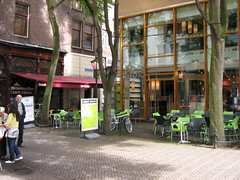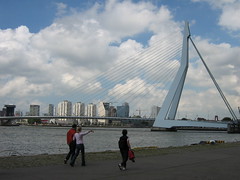I’ve walked up and down this street a couple of times, but haven’t yet had a chance to really explore the shops there–this section has only pedestrian traffic, which I love. Yesterday I at least made it into a cheese shop and it was amazing. The light on the street was good too, so even though I was rushing, I couldn’t resist a few pictures. This was taken around 5:30, so there aren’t so many people and many shops are closing– a lot aren’t even open on Monday and those that are close early. This city is SO not aimed for tourists! It’s great to be somewhere that isn’t all designed to extract the maximum in tourist dollars, but instead is focused on the people who live there.
Category Archives: Netherlands
Erasmusbrug
Another oft photographed view. The nicest part (I think) is that the bridge has a walkway, so you can stroll across and enjoy nice views of the city.
I had been at the graduation show for the Willem de Kooning Academy, which is connected to Piet Zwart and houses the BA programs. It was an interesting show with very high qualities of craftsmanship, especially in the graphic design section. What most struck me though was that though several students in different sections were doing web design, their approaches were often very conventional. They didn’t seem to be experimenting in the same way as even the first year MA students in Media Design are doing. That surprised me since only one year of work separates them, in many cases.
The students all had business cards and most had websites, which struck me as very useful and created a very professional image. I’ll have to remember that for later.
And even more plenary…
Interesting start; Katy Borner is talking about how the amount of knowledge out there has grown enormously and yet our brains are not getting any bigger, and there’s not a good way to extract it automatically. How can we create infrastructures to help us? Google is good, but doesn’t show patterns and trends and outliers.
One approach is to create maps. Example of Co-Authorship of IEEE papers from 2004 shows different patterns between say colleagues in a lab or a professor at a university, and also shows that these are all local networks–most connections are to people physically close.
She and her colleagues developed maps of science which they use to educate kids about how science works. They develop them by searching different databases. But now onto her main topic (!).
- We need software glue to interlink datasets and algorithms written in different language using different data formats.
- The smaller the glue or ‘CI Shell’ the more likely it can be maintained.
- Dataset and algorithm ‘plugins’ are provided by application holders/community users
- Applications resemble custom ‘fillings.’
Cyberinfrastructure Shell (CIShell) is an empty shell that support many functions. She then goes into detail about some tools like Network Work Bench and one she didn’t mention but I found online.
NNT, Day 2 plenary
Ok, back to the present, and more catch up later. Today we start with Nosh Contractor talking about the motives that drive people to participate in social networks–there are lots of possible reasons, some economic, some social, mixed, etc. He is doing research to collect lots of data on motives with the aim of creating a “contextual ‘meta-theory’ of social drivers for creating and sustaining communities.”
He identifies different kinds of theories and their claims, and different kinds of motives these theories focus on.
Collecting data and testing different theories has been difficult until now, because of the web/internet, being able to see the connections and also the behavior and motives as made visible not just in links but also in posts, tags, etc. “It’s all about ‘Relational Metadata'” –ref Katy Borner.
Some tools available now for text-mining, web-crawling, web of science citation data that can let us develop multi-dimensional network models. –I need to check one he’s demonstrating called Crawdad; sounds really interesting. Next he shows several examples of how his research group analysed several networks and helped them be better connected, and wraps up reiterating how a multidimensional model that includes many kinds of connections and nodes helps us better understand networks. Cool.
Back to live blogging
OK, I charged the battery a bit, so now back to live reporting on the first day, just in time for the very last talk by Florian Cramer. I’ll go back and post my notes from the others later. A nice intro by Matthew Fuller who mentions that among other things, Florian has won in a new category for Prix Ars Electronica for best contribution to media theory. He seems embarrassed by it being mentioned. Unlike most of the other speakers, Florian is (as usual) eschewing slick presentation styles and just giving us white on black screens that look like (and in fact I think are) what you get in a terminal window.
I had the chance to see Florian’s original presentation notes and of course he’s not following them, which means now I have trouble identifying what I really need to note down. So what is he saying…he starts with talk of an “elegant paradox” between the syntactic, linear aspects of language and the paradigmatic, that is associative meanings of words. so there has always been a sort of weblike character to texts and in fact textus actually means web.
Then we are on to Barthe turning everything into a text, from beefsteaks, to striptease, to well, anything. At the same time, traditional philologists think of text as only about paper. Computer tech though has allowed us to see what really texts are or aren’t. Ok, now I know where we are.
Syntax –> what is computable
Semantics –> what is computable only if turned into syntax
so text is just an amount of (in most cases alphanumeric) symbols
You can’t really get this from a beefsteak or striptease.
So webs and networks have comparable limitations.
You can describe any network in a flat linear way, the complexity can be boiled down. But he is not proposing this as reduction, but as analysis. So maybe networks are not so different from anything else. (such as texts).
Just as texts were initially defined as anything, and we were in linguistic trap, now everything is networks and we seem to be falling into a technological trap. Despite the humanist agenda, since the 40s, the sciences were mapped onto culture, which leads to a variety of problems.
(big jump here, because I had to stop and really listen. Damn him for saying something interesting and dense)
With the assumption that the media is the message, media theory became sort of a rehash of cybernetics. The network is another cybernetic metaphor that conflates things should be differentiated. But cybernetics also takes these things literally, so interdisciplinary work always teeters on the edge of falling into the trap of mistaking a metaphor for a model.
Critical theory should be wary of taking these metaphors too far. Cultural studies and media studies have too often bought into techno-hype, and used technological terms too sloppily. He gives an example of how “signal-to-noise-ratio” is a concrete mathematical concept, but also is used in discussion lists, first as a metaphor, but then applied in the creation of semantic filters, which is questionable.
So remember:
Storage is not memory, feedback is not interaction, data is not knowledge, computation is not cognition.
A new network theory would have to consider the networks of metaphors spun and the conflations in a critical way even as it uses them. (that’s rather provocative since he’s basically implying that up to now we haven’t been doing this…in fact could be read as a criitique of this conference’s themes…) Oops low battery again, questions are interesting and so are Florian’s answers, but I have to stop. More later.
More About the Trip
So, more about the trip. I’ll be in Amsterdam for one conference and Utrecht for the second, but I’ll actually be spending most of my time in Rotterdam. Or as my Lonely Planet Netherlands guide calls it, “Mighty Rotterdam.” 🙂 I haven’t actually been there yet, but I suspect R’dam is seriously underrated. I mean, quaint old buildings are nice, I like them a lot, but when they are filled with stoned American college students, they lose their charm.
Rotterdam, on the other hand, is not so infested, has really amazing architecture, and excellent design being practiced in general. I’m looking forward to visiting a city where things are really going on and the main industry is not tourism. (I’m not saying this is true of Amsterdam, but certainly it’s a prominent feature there.) I’ll be staying there during my trip and in between conferences I’ll be interviewing people at various cultural institutions and schools that are involved with New Media (or cyberculture, or whatever term we are using this week). And, on top of that, my university and the Piet Zwart Institute Media Design program are working out a joint Master of Arts program, so I am meeting with people there too. They are putting me up, which has allowed me to stay for 16 days. I’m really excited to have such a nice long visit and am practicing my Dutch.
Yes, nearly everyone there does speak English fluently, but for one thing, it’s just polite to at least learn how to say “hello,” “please,” and “thank you.” In my case though, it’s a little more of an issue because I have a Dutch last name and I guess I am tall enough and blondish enough to be taken for a native and it’s embarrassing to be completely ignorant. Actually, not entirely ignorant, because I studied Old Saxon in grad school, from which both English and Dutch have developed. So sometimes when I hear some Dutch, I understand a lot without being able to really say how. Anyway, if you want to practice a little Dutch, try the Laura Speaks Dutch
website, by Brenno de Winter. Rather than being like a standard lesson, it’s more like talking to someone about the Netherlands and about speaking Dutch, and I find it sinks in better. You can also find it in iTunes.
Next time maybe some more about the interviews–the whys and whos.

